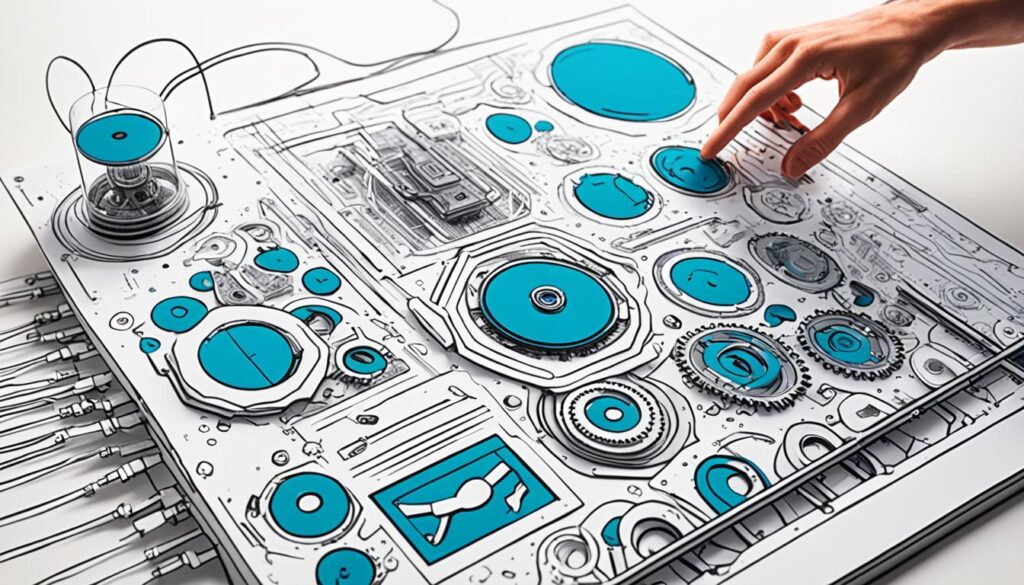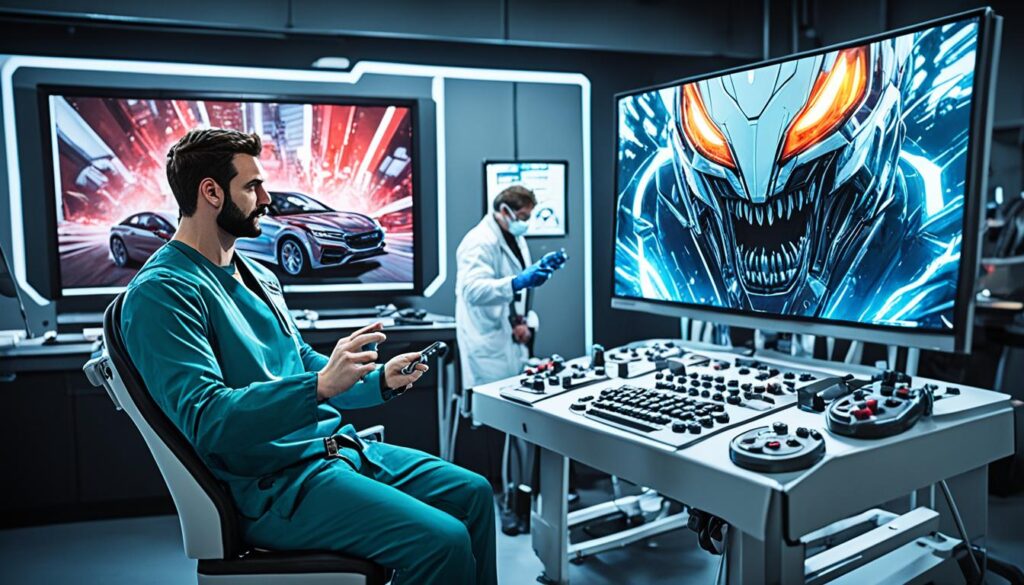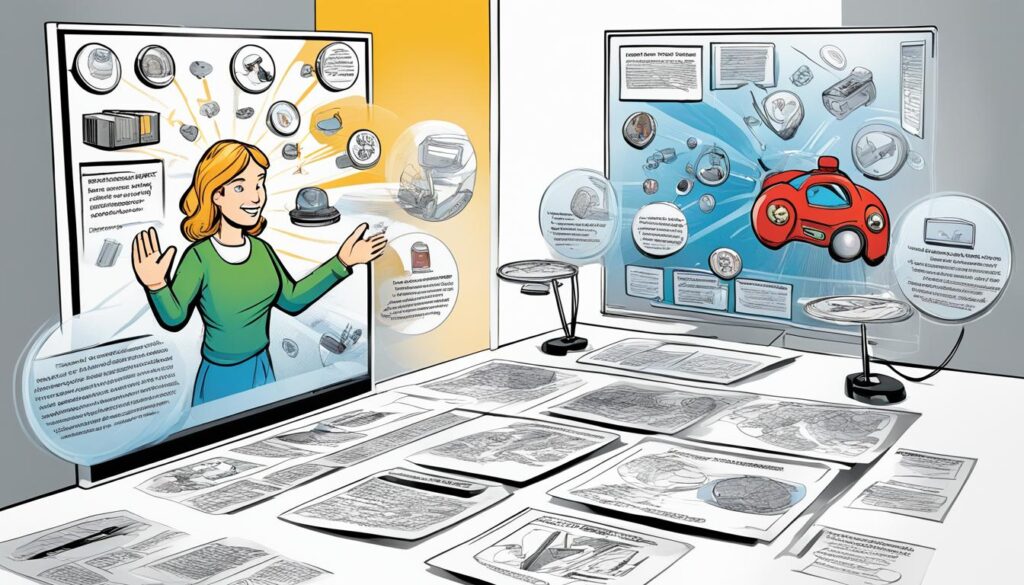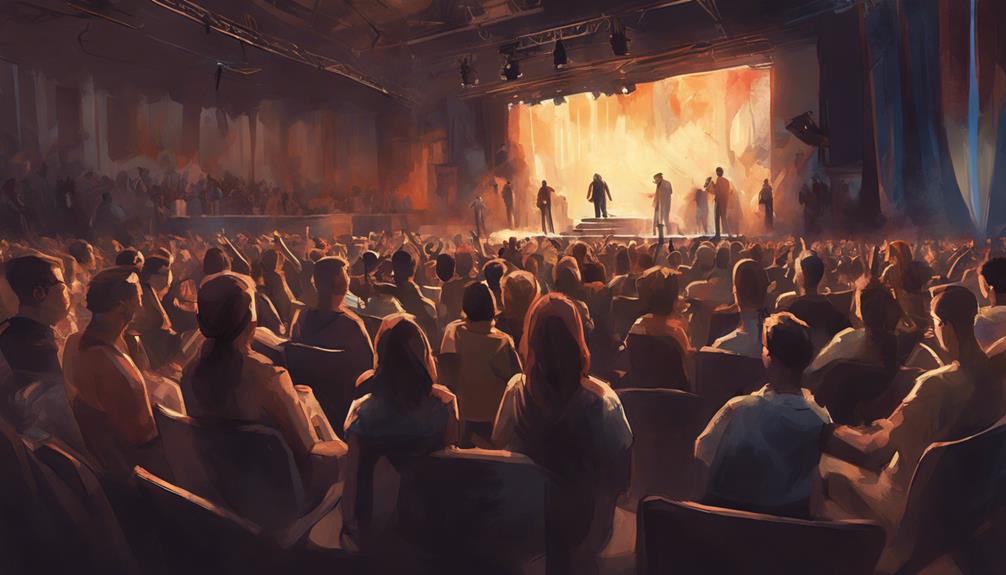Imagine a digital world that feels as real as the one we live in. Haptic technology, or haptics, merges digital and real experiences. It lets users connect with technology through touch. This tech is changing how we interact with games, virtual reality, and medical training. It’s used in many areas, making tech feel more real by giving tactile feedback.
Haptics is evolving beyond just feeling real. It’s helping us understand complex topics in education and more. The haptic tech market is expected to grow from $2,227.39 million in 2022 to $18,349.94 million by 2030. That’s a yearly growth rate of 30.7%. There’s growing demand in electronics and healthcare1. We will look into haptic technology’s definition, history, how it works, its uses, benefits, and what’s next.
Key Takeaways
- Haptic technology creates realistic touch experiences in digital applications.
- The market for haptic technology is rapidly expanding due to increasing demand.
- Applications of haptic technology range from gaming to medical training.
- Research focuses on enhancing educational methodologies using haptic feedback.
- Continued innovation in haptic interfaces is expected to improve various sectors.
What is Haptic Technology?
Haptic technology is about improving our sense of touch. It allows us to feel virtual objects as if they were real. This is done by mimicking physical interactions. The word “haptic” comes from the Greek “haptesthai,” meaning “to touch.”
This technology is significant because it gives us sensory details about our interactions. This makes our experiences feel more real and immersive.
Definition and Overview
Haptic technology involves various methods to stimulate our sense of touch. It does this by imitating sensations like pressure, weight, and texture. This is possible through systems like vibrations created by linear resonant actuators and movements by eccentric rotating mass actuators2.
Its uses go beyond just fun and games. It includes medical training, robotics, and even building design through virtual architecture3.
Purpose and Functionality
The main goal of haptic technology is to make digital experiences feel more real. It’s used in smartphones and games where you can feel driving in a controller3. It includes different types of feedback like force, vibrotactile, and tactile feedback. These provide unique sensory experiences.
Looking ahead, we might see exciting developments. Imagine displays and wearables, like gloves that let you touch virtual objects32.
| Type of Haptic Feedback | Description | Common Applications |
|---|---|---|
| Force Feedback | Simulates physical resistance and movement. | Gaming controllers, simulators. |
| Tactile Feedback | Provides realistic sensations like touch and texture. | Mobile phones, touchscreen devices. |
| Vibrotactile Feedback | Offers various vibration patterns to simulate interactions. | Wearable devices, VR controllers. |
| Thermal Feedback | Conveys temperature changes to enhance realism. | Educational simulations, gaming experiences. |
Haptic technology is versatile and serves many purposes. It boosts user engagement by offering specific sensory feedback32.
Origins and Evolution of Haptic Technology
The story of haptic technology is quite interesting. It began with simple ideas and grew into complex systems that make our experiences better. Early efforts were about adding touch feedback to different systems. This work laid the groundwork for what we have today.
Historical Background
During World War II, the first systems with haptic feedback were used in aircraft. They helped pilots stay safe by telling them about conditions outside4. In the 1960s, Paul Bach-y-Rita invented a system to help people see using touch. It had a grid of metal rods4. In 1973, the first patent for a tactile telephone was awarded to Thomas D. Shannon. This opened doors for new ways to communicate through touch5. Then in 1975, A. Michael Noll made an early system for humans to interact with machines. It made important connections between people and technology4.
Significant Milestones
In 1976, Sega’s Moto-Cross game brought in vibrotactile feedback. This was one of the first times a game used such feedback6. In 1997, Nintendo introduced the RumblePak. This game controller with vibration became a big hit in the industry4. The Motorola StarTac, released in 1996, was the first phone with a vibrating feature. It showed how haptic feedback could be used in everyday items4. The Aura Interactor vest, made in 1994, could turn sound into touch sensations5. Nowadays, haptic technology is common in smartphones and game controllers. It makes things more interactive in many areas4.

Mechanisms Behind Haptic Feedback
Haptic feedback systems use different parts to improve how we interact with devices. They do this by giving us a touch experience. The systems have sensors and actuators that work together. Sensors catch what we do and tell the system. Then, actuators create the touch feelings we feel. There are various actuators, like ERM and LRAs. They help make different touch experiences during our use of devices.

Components of Haptic Technology
The main parts of haptic technology are:
- Sensors: These gadgets pick up our actions and tell the system.
- Actuators: They make the touch feelings by changing electric signals into physical sensations.
- Control Systems: These are computer programs that understand our actions and control the touch feedback in real-time.
The first patent for haptic tech was for a tactile phone in 19737. Aviation was one of its first uses. It used vibrating controls to help pilots know more about what’s happening outside the plane7. In the 2000s, Immersion Corporation made advances. They brought haptic feedback to virtual reality. They used wearables on the hands to make users feel more involved8.
Types of Sensations
Haptic technology can create a wide range of feelings:
- Vibrations: These can let users know about new messages or alerts.
- Immersive Feedback: This makes virtual experiences feel more real, like the kickback from shooting in games.
- Texture Simulations: It lets users sense different textures while touching the device.
These feelings make the experience more engaging. They blend touch with what we see and hear. For example, the PlayStation 5’s DualSense controller uses such technology. It has precise vibrations that make gaming more vivid. This is a big step forward from older controllers8. Also, bHaptics makes haptic suits. These suits use vibrations to make virtual reality feel more real, showing how varied haptic feedback can be8 and9.
Applications of Haptic Technology
Haptic technology is changing the way we interact with devices through touch. It is important in gaming, healthcare, and making digital worlds more accessible. This leads to more immersive experiences for everyone.
Gaming and Entertainment
The gaming world is more exciting thanks to haptic technology. It makes games feel more real, like feeling the kick of a gun or the jolt from a bump. This tech brings players closer to the action, making games more fun and engaging2.
Virtual Reality and Augmented Reality
In VR and AR, haptic tech takes things to the next level. It lets users touch and feel virtual objects as if they were real. Imagine wearing gloves that make you feel different textures. This magic bridges the gap between virtual and physical worlds2.
Medical Training and Simulations
Medical training greatly benefits from haptic tech. It lets students practice surgeries in a realistic way. They get to feel what it’s like to work with human tissue without any risks. This is key in helping future surgeons learn faster and safer. After around 170 procedures, they reach an expert level in skills like knee surgery10.
Accessibility Enhancements
For those who can’t see well, haptic technology is a game-changer. It helps them interact with digital content by touch. This opens up new ways for them to be part of the digital community. It proves that haptic tech is vital in making tech accessible for all2.

Advantages of Haptic Technology
Haptic technology is crucial in improving how we interact with devices. It makes our experiences more dynamic by using our sense of touch. This leads to better feedback during use. Studies show haptic technology benefits go beyond fun, impacting education and training.
Enhanced User Experience
Haptic feedback boosts engagement in several industries. A study showed that all participants enjoyed haptic games more than standard ones. They felt more into the game11. In cars, haptics help drivers react faster than with just visual cues. This makes driving safer12. Overall, this technology increases satisfaction, making tasks quicker and less prone to mistakes.
Educational Applications
In education, haptics offer a new way to learn interactively. It changes passive study methods into active, engaging experiences11. Research has found that haptic feedback helps students understand complicated ideas better13. As haptics evolve, they’re set to transform education into a more hands-on, effective experience.

| Aspect | User Experience | Educational Impact |
|---|---|---|
| Engagement Levels | High, with immersive feedback | Active learning preferred over passive learning |
| Performance Improvement | Enhanced reaction times and error reduction | Tactile interaction fosters understanding |
| Application Areas | Gaming, Automotive | Simulation-based learning, Hands-on training |
| Market Potential | Estimated to reach $10 billion by 2026 | Growing interest in haptic tools for education |
Haptic technology is changing how we interact with devices and learn new things. It sets new standards for our daily tech use, from gaming to education111213.
Future Trends in Haptic Technology
The world of technology is always changing, and haptic technology is no exception. It is set to bring amazing innovations. Developers are working hard to make devices feel more real. This means things like textures and how things respond to touch will get much better. These improvements will change how we use smart devices across many fields, making our experiences richer.
Emerging Innovations
Haptic technology is moving forward fast. Right now, more than 3 billion devices around the world have haptic features. This includes things we use every day like smartphones and wearable gadgets14. Take Apple’s Taptic Engine, for example. It uses a special motor to make it feel like you’re pressing buttons, even though you’re not. This makes using devices a lot more fun and realistic15.
Integration with Wearables
Wearable technology is also getting in on the action. Smartwatches and fitness bands are starting to use advanced haptic feedback. This means they can let you know about notifications with subtle vibrations15. Google’s Project Jacquard is even putting touch sensors into clothes. This blend of digital and real-world interaction opens up new ways for us to engage with our environment.

There’s also good news for people with disabilities. Haptic technology is being designed to help them interact better with technology through touch15. Studies have found that people can remember objects with 94% accuracy just by touch. This shows how powerful haptic technology can be for boosting memory and interaction14. Plus, the haptic tech market is expected to grow a lot by 2026, promising exciting developments ahead14.
Conclusion
Haptic technology is changing how we connect with digital worlds. It’s becoming key in fields like gaming, medical training, and consumer gadgets. This wraps up our discussion on haptic tech. It shows adding touch can make our interactions more lively and impactful across several industries.
Haptic feedback’s rising fame in gadgets is worth noting. But, we must think about its touch impact and the research costs. Adding haptic feedback makes experiences more engaging. Yet, it brings technical challenges. Issues with sensors and actuators can mess with the accuracy of feedback1617. Getting the right tactile feedback means picking components wisely to better user experiences.
The road ahead for haptic tech is filled with potential. It’s set to close the gap between our virtual and real interactions in ways unseen before. By using modern actuators and microcontrollers, industries will make devices easier to use. They’re setting the stage for new, exciting ways to interact in the future16.
FAQ
What is the primary function of haptic technology?
How does haptic technology impact gaming experiences?
In which industries is haptic technology currently utilized?
What are some examples of haptic feedback?
How does haptic technology improve accessibility for visually impaired users?
What advancements can we expect in the future of haptic technology?
What is the role of sensors and actuators in haptic technology?
How does haptic technology enhance educational experiences?
How is Haptic Technology Used in Diverse Ferrofluid Applications in Tech?
Haptic technology is utilized in diverse ferrofluid applications tech to enhance user experiences. From creating responsive touchscreens to developing realistic virtual simulations, the use of ferrofluid in haptic technology offers a wide range of possibilities in various tech applications.
Source Links
- https://in2tec.com/company/insights/exploring-haptic-technology-and-innovation-for-smart-hmi – Exploring haptic technology and innovation for Smart HMI
- https://www.spiceworks.com/tech/tech-general/articles/what-are-haptics/ – What Are Haptics? Meaning, Types, and Uses
- https://flatirons.com/blog/haptic-feedback-device/ – Haptic Feedback: What is an Example of a Haptic Device? – Flatirons
- https://titanhaptics.com/understanding-haptics-a-journey-through-the-history-and-evolution-of-haptic-technology/ – Understanding Haptics: A Journey through the History and Evolution of Haptic Technology – TITAN Haptics
- https://en.wikipedia.org/wiki/Haptic_technology – Haptic technology
- https://teslasuit.io/blog/history-haptic-technology/ – History of Haptic Technology in Video Game Industry | Teslasuit Blog
- https://www.d-box.com/en/haptic-technology – Everything you need to know about haptic technology
- https://builtin.com/hardware/haptic-technology – What Is Haptic Feedback? | Built In
- https://flatirons.com/blog/haptic-vs-tactile-feedback/ – Difference Between Haptic and Tactile Feedback
- https://www.frontiersin.org/journals/robotics-and-ai/articles/10.3389/frobt.2021.612949/full – Frontiers | Applications of Haptic Technology, Virtual Reality, and Artificial Intelligence in Medical Training During the COVID-19 Pandemic
- https://titanhaptics.com/why-haptics-unveiling-the-benefits-and-applications-of-haptic-technology/ – Why Haptics? Unveiling the Benefits and Applications of Haptic Technology – TITAN Haptics
- https://www.swindonsilicon.com/what-is-haptic-technology/ – What is Haptic Technology? – Swindon Silicon Systems
- https://www.bairesdev.com/blog/your-app-needs-haptic-feedback/ – Why you Need Haptic Feedback in your App – BairesDev
- https://masschallenge.org/articles/haptic-technology/ – Haptic Technology: The Future of Engagement? – MassChallenge
- https://www.ala.org/future/trends/haptic – Haptic Technology
- https://www.egr.msu.edu/classes/ece480/capstone/fall14/group04/assets/appnote_michael.pdf – PDF
- https://flatirons.com/blog/disadvantages-of-haptic-technology/ – The Disadvantages of Haptic Feedback Technology










